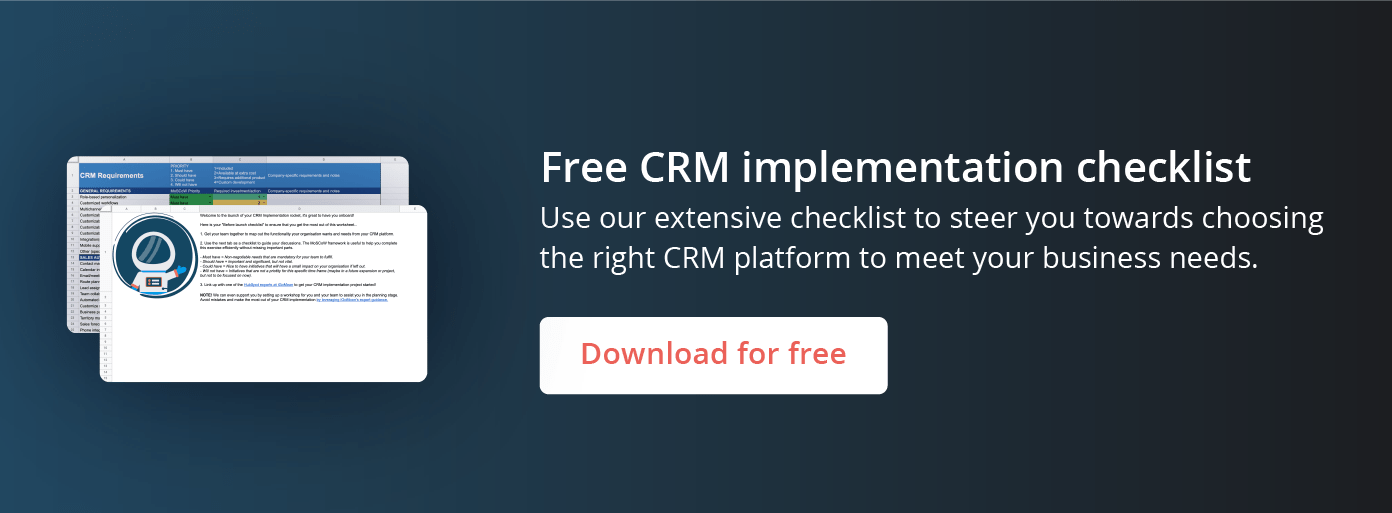The fact that your business needs a new CRM can depend on many reasons such as complexity, lacking features, growth or maybe a combination of these. To be able to implement a CRM system successfully, it has to be easy to use or your team won't use it.

1. You have outgrown your existing CRM
At iGoMoon we know the startup life and what it entails, after all iGoMoon was built with a bootstrap mentality - growing as we contributed to the success of our customers. When you are a small and newly started business you need to find creative ways to stay effective while keeping costs down. If you missed that HubSpot offers a free CRM you might even have opted for another CRM provider that no longer serves your business needs.
Some solutions are more cost effective in the early stages of a company's development, but you might be facing mounting costs as your company scales - finding that other solutions will give you "better bang for your buck" or an improved functionality that meet new needs. You might also find yourself in a situation where you want to house several departments "under the same roof" to make reporting easier, and break silos that will lead to inefficiency and frustrated customers.
The reasons for making the change are many, and quite often, it's the fear of change that holds most companies back. Some times a hero needs to come along to drive an initiative like this forward, someone that has the capacity to see why making the change is vital - and how it will help your business grow its revenue through delighting more customers.
2. It doesn't support your needs for integration
It happens in the best of relationships, some times you simply grow apart - and that's ok! As companies grow, the need for additional systems typically arise on several fronts. What was fine in the early days of your journey, might leave you longing for more as your organisation becomes larger and increasingly challenging to manage. When this happens, you might discover that your organisation could benefit greatly from having your systems "speak to each other" and transfer data between them for reporting purposes. This typically leaves companies with two options:
- Change CRM to a more advanced provider.
- Stick with your current CRM and hire developers to build a custom integration.
Depending on the complexity of your integration the price tag on building custom integrations will also vary. Keep in mind that maintenance costs to keep your integration(s) updated as your CRM provider launches new features should also be part of your equation. One of the advantages with HubSpot's CRM is that they operate from a philosophy of being an "All-ON-one-platform", as opposed to an "All-IN-one-platform". This means that HubSpot offers a host of excellent integrations, built and maintained in-house by their own developers.
Can't find the integration you need on the HubSpot App Marketplace? We specialise in building ERP integrations for the HubSpot ecosystem.
3. Your CRM is not being used because it is too
complex or lacking features
In the early days, it might have been fine to collect reports from your marketing, sales and customer service teams from a combination of Excel sheets and PowerPoint presentations. But with increased complexity and volume, this labor-heavy way of reporting takes away too much energy from serving your customers and bringing in new business. Changing to a sophisticated CRM solution can automate many of your reporting needs and free up time for your teams to do more customer facing work. The best part? Your reports are also likely to become faster, better and less dependent on individuals.
In short, if your CRM is intuitive and easy to use - people in your organisation will use it!
Thinking about changing? Check out our CRM Fundamentals Workshop.
4. You have a hard time implementing it across your organisation
The harder it is to navigate and use a CRM, the less likely your team is to interact with it in the way you intend. Working in your CRM should be a breeze, with powerful tools, an intuitive user interface, and preferably also an outstanding app that allows you to perform certain tasks when you are on the go.
As you scale up, you will probably face a substantial training need when onboarding new colleagues. In those inevitable onboarding processes you might want to consider a CRM provider that has excellent training resources. HubSpot Academy definitely checks off this box, where you can find resources for everything from how to use HubSpot's own tools, to creating a sales plan and working with contextual marketing. By combining these fantastic resources with your own onboarding process, you can ensure that your colleagues are competent, confident, and excited about the tools you place in their toolbox.
iGoMoon has helped several companies with their CRM implementation journeys - Get in touch to explore how we can support your organisation with implementing the HubSpot CRM.
5. Expansion and hybrid/remote work requires new features
Remote workers need to be able to access the information they need, even when working from home. Your existing CRM solution might have done a good enough job of providing this transparency when everyone is in the office. But not being able to run into a colleague from the sales department at the coffee machine, or having lunch with someone from your customer success team, will in most cases put higher demands on your technical solutions.
A single source of truth is a strong advantage when you are diving into the data to pull reports, but it is also critical to have a shared reality when the customer facing team members are following up on a lead, or supporting an existing customer with an issue. With the HubSpot app you will have access to all your leads and contacts as long as you keep a smartphone in your pocket. Make sure that you take remote capabilities into account when exploring which solution is best for the next chapter in your adventure.
